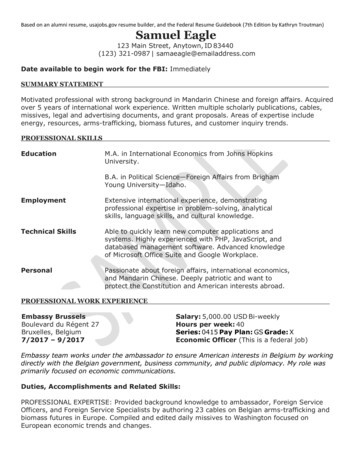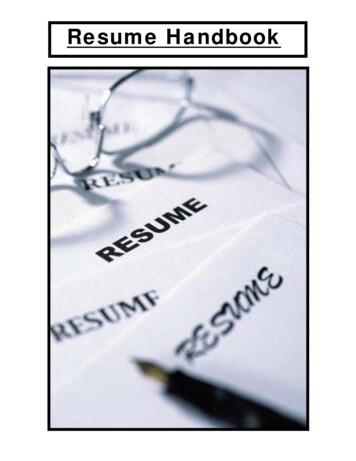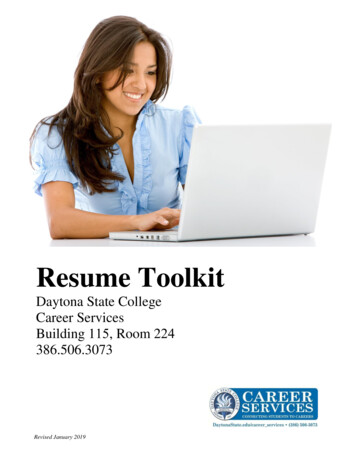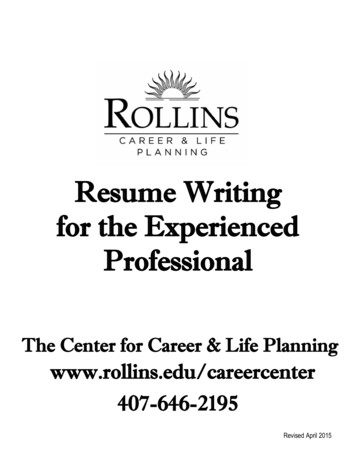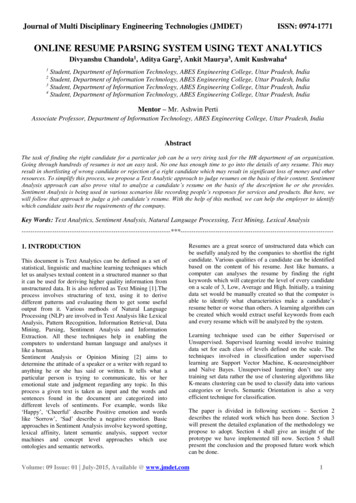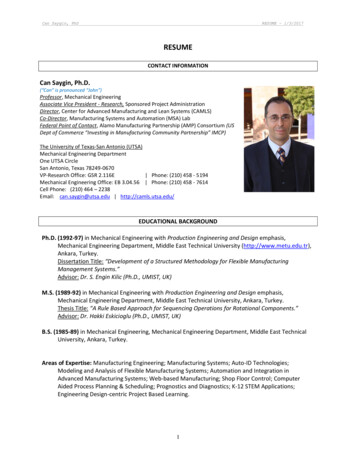
Transcription
Can Saygin, PhDRESUME – 1/3/2017RESUMECONTACT INFORMATIONCan Saygin, Ph.D.(“Can” is pronounced “John”)Professor, Mechanical EngineeringAssociate Vice President - Research, Sponsored Project AdministrationDirector, Center for Advanced Manufacturing and Lean Systems (CAMLS)Co-Director, Manufacturing Systems and Automation (MSA) LabFederal Point of Contact, Alamo Manufacturing Partnership (AMP) Consortium (USDept of Commerce “Investing in Manufacturing Community Partnership” IMCP)The University of Texas-San Antonio (UTSA)Mechanical Engineering DepartmentOne UTSA CircleSan Antonio, Texas 78249-0670VP-Research Office: GSR 2.116E Phone: (210) 458 - 5194Mechanical Engineering Office: EB 3.04.56 Phone: (210) 458 - 7614Cell Phone: (210) 464 – 2238Email: can.saygin@utsa.edu http://camls.utsa.edu/EDUCATIONAL BACKGROUNDPh.D. (1992-97) in Mechanical Engineering with Production Engineering and Design emphasis,Mechanical Engineering Department, Middle East Technical University (http://www.metu.edu.tr),Ankara, Turkey.Dissertation Title: “Development of a Structured Methodology for Flexible ManufacturingManagement Systems.”Advisor: Dr. S. Engin Kilic (Ph.D., UMIST, UK)M.S. (1989-92) in Mechanical Engineering with Production Engineering and Design emphasis,Mechanical Engineering Department, Middle East Technical University, Ankara, Turkey.Thesis Title: “A Rule Based Approach for Sequencing Operations for Rotational Components.”Advisor: Dr. Hakki Eskicioglu (Ph.D., UMIST, UK)B.S. (1985-89) in Mechanical Engineering, Mechanical Engineering Department, Middle East TechnicalUniversity, Ankara, Turkey.Areas of Expertise: Manufacturing Engineering; Manufacturing Systems; Auto-ID Technologies;Modeling and Analysis of Flexible Manufacturing Systems; Automation and Integration inAdvanced Manufacturing Systems; Web-based Manufacturing; Shop Floor Control; ComputerAided Process Planning & Scheduling; Prognostics and Diagnostics; K-12 STEM Applications;Engineering Design-centric Project Based Learning.1
Can Saygin, PhDRESUME – 1/3/2017PROFESSIONAL EMPLOYMENT HISTORYACADEMIC09/2012 - present: Professor of Mechanical Eng, University of Texas at San Antonio (UTSA).08/2006 – 09/2012: Associate Professor (tenured) of Mechanical Eng, UTSA.09/2005 – 08/2006: Associate Professor (tenured), University of Missouri – Rolla (UMR*), EngineeringManagement and Systems Engineering (EMSE) Department, Rolla, Missouri.* Since 2008, UMR is MS&T “Missouri University of Science and Technology”02/2000 – 09/2005: Assistant Professor (tenure-track), UMR, EMSE.08/1999 – 02/2000: Lecturer (H1B pending/due to visa status), UMR, EMSE.08/1998 – 08/1999: Visiting Assistant Professor, University of Toledo, Mechanical, Industrial, andManufacturing Engineering Department (MIME), Toledo, Ohio.09/1997 – 08/1998: Post-Doctoral Research Associate / Adjunct Faculty, University of Toledo, MIME,Flexible Manufacturing Systems Laboratory (Director: Dr. F. Frank Chen), Toledo, Ohio.1989-1997: Graduate Research/Teaching Assistant in Production Engineering and Design, MechanicalEng. Dept., Middle East Technical University, Ankara, Turkey.ADMINISTRATIVE09/15/2016 – present: Associate Vice President for Research, Office of Sponsored ProjectAdministration, University of Texas at San Antonio (UTSA).09/01/2015 - present: Director, Center for Advanced Manufacturing and Lean Systems (CAMLS), UTSA.03/16/2014 – 09/15/2016: Assistant Vice President for Research, Office of Sponsored ProjectAdministration, UTSA.05/15/2013 – 03/16/2014: Interim Assistant Vice President for Research, Office of Sponsored ProjectAdministration, UTSA.03/2012 – 05/2013: Dean’s Fellow for Strategic Initiatives, College of Engineering, UTSA.11/2008 – 05/2013: Center Director, Interactive Technology Experience Center (iTEC) – K-12 STEMCenter, College of Engineering, UTSA.09/2007 – 12/2011: Director of Graduate Programs (Graduate Advisor of Record) in Mechanical EngDept: MS in Mech Eng, MS in Advanced Manufacturing and Enterprise Engineering, and PhDin Mech Eng.10/2006 – 5/2011: Director of the Machine Shop, College of Engineering, UTSA.06/2004 – 08/2006: Co-Director of the Auto-ID Research Group, University of Missouri-Rolla (UMR),Rolla, Missouri.06/2000 – 08/2006: Director of the Integrated Systems Facility, UMR, Engineering Management andSystems Engineering (EMSE) Department, Rolla, Missouri.2005-2006: Undergraduate Advisor for Manufacturing, UMR, EMSE.10/1997 – 09/1999: Group Coordinator, Flexible Automation and Integrated Manufacturing (FAIM)Research Group, University of Toledo, Mechanical, Industrial, and Manufacturing Engineering(MIME) Department, Toledo, Ohio.1995 – 1997: Group Coordinator, Integrated Manufacturing Technologies Research Group, Middle EastTechnical University, Mechanical Engineering Department, Ankara, Turkey.2
Can Saygin, PhDRESUME – 1/3/2017ADMINISTRATIVE EXPERIENCEAssociate Vice President for Research – Sponsored Project AdministrationI started as Assistant VP-Research, in May 2013, in charge of the Office of Sponsored ProjectAdministration (OSPA) in the Office of the Vice President for Research (VPR). In Sept 2016, I have beenpromoted to Associate VP-Research, with expanded role in research support. OSPA team includes 37staff members and 3 primary functions (Research Service Centers, Grants and Contracts FinancialServices, and Contracts and Industry Agreements) to support the UTSA’s research mission: SupportingUTSA's research community by facilitating growth, enabling productivity, and pursuing excellence.My primary focus in the first 6 months was on enforcing a change in culture by introducingoperational metrics, key performance indicators, and accountability while redesigning businessprocesses for core functions and facilitating personal development for staff. The second 6-month periodwas focused on improving productivity and revisiting all the IT platforms and tools that are used as partof research administration across UTSA, which also included Peoplesoft. In 2014, as VPR ExecutiveTeam, we focused on developing a framework document to guide UTSA in its journey to Tier One Status;the framework is entitled “Accelerate 2025: UTSA’s Framework for Top Tier Research”. We have startedthe implementation phase in 2015 by working very closely with the President, Provost, Deans,Department chairs, and faculty.(See 2/Accelerate 2025.pdf for “Accelerate 2025”)I was selected in 2014 by the President as one of 8 people to form the “Blueprint StrategicPlanning Task Force” (still continuing) to plan, manage, and execute the overall process, which hasallowed me to experience the operational aspects of the institution as a whole at all levels.(See http://www.utsa.edu/blueprint/ for “UTSA Blueprint”)I also interact with the University of Texas (UT) System level executives and administrators onvarious issues that apply to multiple UT campuses and I serve on UT System level committees. The AVPposition has given me an opportunity to see priorities and their interaction at various levels across theUT System.The AVP-Research position has provided me with an in-depth perspective of strategic andoperational aspects of an academic enterprise and allowed me to see how essential functions of ahigher education institution are related. More specific perspectives and experiences I have acquired inthis position are as follows: An in-depth analysis of structure, performance, and resources of similar or aspirant institutionsis very important to create a baseline understanding of the research mission of the institution. Mapping institutional goals beyond “research” (academic affairs, community services, economicdevelopment, etc) and understanding the possible conflicts among these goals andcomplimentary issues creates a domain of restrictions that should be studied carefully. Only inthis way, strategic actions and their deployment can be communicated properly and executedsuccessfully. The process to define the research mission, the process must be paced properly and be veryinclusive; combinations of vice presidents, provost, deans, faculty, center directors, graduatestudents, and support staff must be carefully consulted with. We all know that due to sharedgovernance, academic decision-making processes are cumbersome; they lack speed andefficiency. Therefore, it is imperative to enable the creation of a broad base of all thesestakeholders and to make their voices heard to avoid future conflicts. Based on my engineeringbackground, this process is the “modeling” phase to solve a complicated problem. Success insolving such a complicated problem requires the model to be defined at the right granularity(detail) level.3
Can Saygin, PhD RESUME – 1/3/2017The pace of the planning activities must be just right (Not too fast, not too slow). If the pace istoo fast, then details may be missed or not all voices are heard. If the pace is too slow, then welose focus; the dynamics on campus change and other priorities emerge.In an institution where “research” is defined and measured using different metrics (notmeasured primarily by proposals, awards, and expenditures), it is important to discuss and agreeupon a broad set of metrics that apply to different colleges. How to monitor metrics and how totie accountability to metrics must be clearly identified.These issues (bullet points above) must be communicated over and over by VPR, as well as byPresident and other VPs. Consensus through a common voice at the “executive level” makes it astrong message that the campus needs to hear (not once but many times in various formats).Colleges, departments, and R&D centers must be given the opportunity to develop their ownstrategic directions that match the institutional goals and missing.Academic Affairs (Provost) initiatives must be considered when developing researchenhancement plans to minimize conflicts between VPR and Provost. The role of the president tomake the connection between academic affairs and research is very critical.Deans are crucial in contributing and implementing research plans. Each dean must be aprominent player in the planning phase and own the process so that they can effectively workwith the department chairs and faculty in their colleges.Research Centers and Institutes must be included as a separate category since they operatedifferently than academic departments and their needs and areas of expertise can provide newopportunities and strategic areas.Research enhancement plans should not solely focus on the destination of where the institutionwants to be in terms of research productivity but also on the journey to get to the destination; adeployment plan that realistically combines resources with an implementation timeline andmetrics for monitoring progress of deployment must be developed.Understanding of current faculty needs, desires, and expectations across different colleges andacademic departments is very critical in terms of goal setting. Implementation activities andtasks will be typically different for new hires, mid-career faculty, and faculty who are close toretirement.In academia, it is all about “transition”. I strongly believe that, in spite of how good theintentions are, when strategic plans are developed and managed in the absence of intentionallydesigned accountability and measurable metrics, effective time management with feedbackloops and alternative paths, realistic resource alignment, strong project management team, andpatience to reach the targets, they always fail.Center for Advanced Manufacturing and Lean Systems (CAMLS)(http://camls.utsa.edu)In 2006, I was hired to primarily contribute to the College of Engineering’s mission to bring“manufacturing engineering” to UTSA. Together with Dr. F. Frank Chen, we joined UTSA in August 2006.Developing undergraduate and graduate-level courses in manufacturing and establishing a researchcenter that integrates with local industry were the two ultimate goals. In research center part of themission, I have worked very closely with Dr. F. Frank Chen to establish the Center for AdvancedManufacturing and Lean Systems (CAMLS). We have written an internal proposal to make CAMLS aformal research center at UTSA, which was approved in March 2007. We have also visited andcommunicated with several industries/companies and potential partners with the objective of (1) lettingthem know that UTSA is establishing programs in manufacturing engineering, (2) presenting them ourresearch and development potential in advanced manufacturing and lean systems, (3) requesting4
Can Saygin, PhDRESUME – 1/3/2017semester projects, senior design projects, and internships. Currently, CAMLS has several affiliatedfaculty members, member companies, and graduate students in the MS/AMEE program working onCAMLS projects. Since 9/1/2015, I am serving as Director of CAMLS. My efforts are focused on appliedresearch, development, industrial training, and economic development.Dean’s Fellow for Strategic Initiatives in College of Engineering, 03/2012 – 05/2013This position gave me an opportunity to work in the Dean’s office on special projects and get a close-uplook at academic administration. My responsibility, as the first Dean's Fellow, was to work towardestablishing 1) continuing education programs, including online degrees and certificate programs (LandManagement Certificate, BS Degree in Industrial Engineering), 2) procedures for improving teachingeffectiveness, and 3) an internal system for identifying eligible and deserving COE faculty andnominating them for external awards from professional organizations.Center Director, Interactive Technology Experience Center (iTEC), College of Engineering, 11/2008 –5/2013: (http://itec.utsa.edu)Interactive Technology Experience Center (iTEC – http://itec.utsa.edu) is a K-12 STEM center,funded for its first 4 years by the AT&T Foundation. Its goal is to inspire young people by creating anenvironment where they can understand how engineering, science, and technology shape our lives andthe future of the world. iTEC’s mission is to motivate young people to pursue careers in engineering bydemonstrating advanced technologies and engaging them in interactive activities that build technicalskills and foster critical thinking, self-confidence, communication, and leadership. As iTEC Director, myresponsibility was to coordinate the research and development efforts among six faculty members,manage a 1.5M (for 4 years) budget, establish a state-of-the-art facility for K-12 students and teachers,and demonstrate engineering and technology in an interactive way to increase awareness and interestin engineering. iTEC operates as an outreach entity for the College of Engineering and as iTEC director, Irepresented the College in various K-12 activities. The effort during 2008-2011 has been funded by theAT&T Foundation.Towards the end of funded era of iTEC (2008-2010), I was asked by the Dean of Engineering todevelop a business model to self-sustain iTEC without any financial support from UTSA. My businessmodel included development of K-12 student and teacher programs to create revenue for iTEC so thatiTEC could sustain its operations beyond 2011. These programs included seminars, workshops, fieldtrips, day camps, spring-break and summer camps, robotics competitions, and train-the-trainerworkshops for teachers. I made major changes in regards to staffing and operational aspects of iTEC. In2012-2013, my staff included a full-time program manager, a full time program specialist, and fiveundergraduate students who worked very closely with me and my staff on scheduling of educationalactivities, hands-on application development, curriculum development, camp and competitionmanagement, and maintained an interactive Web presence. I worked very closely with the UTSADevelopment office to raise funds to sponsor various STEM activities.Beginning in 2011, iTEC started to generate enough revenue under my leadership to self-sustainitself and grow. The revenue was approximately 250K per year. Our typical activities included a springbreak camp for over 250 students, over 900 students in summer camps, approximately 1,500 peopleattending the annual robotics competition, and year-round programs at a dozen schools through our“iTEC on Wheels” programs. On average, iTEC connects with over 4,000 people every year. In May 2013,I turned over my director role to another faculty member due to the AVP-Research position I accepted.Since then, iTEC is still running under the business model I developed.5
Can Saygin, PhDRESUME – 1/3/2017Graduate Program Director for Graduate Programs in Mechanical Engineering DeptMS/ME (2007-2012), MS/AMEE (2009-2012), and PhD/ME (2011-2012):During my service as graduate program director (called “Graduate Advisor of Record” in UTSA),the Master of Science degree in Mechanical Engineering (MS/ME) program has grown from 17 studentsand 3-4 graduate course offerings in Fall 2007 to over 100 students and 15 graduate courses in Spring2011. I led the effort in writing and revising the Master of Science degree in Advanced Manufacturingand Enterprise Engineering (MS/AMEE). I developed a unique program by coordinating the effortbetween the ME and the collaborating departments in the College of Business and the MS/AMEEprogram started in Fall 2009. I have greatly contributed to the writing and revisions of the Doctorate ofPhilosophy degree in Mechanical Engineering (PhD/ME) proposal and assisted the department chairsthroughout the process.For all three graduate programs, I worked very closely with the Graduate School, departmentchair, ME graduate committee, and the ME faculty in developing policies, and implementing proceduresto effectively manage the programs and advise students. In addition to continuously advising tograduate students in these programs, my responsibilities included annual assessment of graduateprograms, organization of various open house events, revisions of graduate catalog, and assistance inscheduling of graduate-level courses. For 5 years, I served on the Graduate Council and worked with theGraduate School Dean, and I served as chair of the ME Graduate Programs Committee.Director of the Machine Shop, College of Engineering, 10/2006 – 5/2012:As director of the College of Engineering Machine Shop between 10/2006 and 5/2012, I mademajor operational and layout changes, and implemented new policies in order to effectively respond tothe needs of the machine shop users, which include faculty across UTSA, senior design students,professional societies, and undergraduate level students for their laboratory applications. Theoperational changes included work order monitoring system to keep track of technicians’ effort onstudent projects and faculty research support activities, automation of monthly workload reports to theCollege of Engineering, swipe card after-hours access procedures, mandatory safety workshops for allactive users, and ABET-related support activities.The layout changes included relocating the welding section away from the SAE Formula Carsection to avoid potential explosions/fire, acquisition of equipment and setting up an educationalmachining laboratory with new manual machine tools and a CNC lathe for students takingmanufacturing engineering-related courses, a Computer Aided Design and Manufacturing (CAD/CAM)laboratory with new computers and software, an Advanced Machining Cell (AMC) in support of Centerfor Advanced Manufacturing and Lean Systems (CAMLS) projects, adding a new welder (with partialsupport from Pratt & Whitney) to the welding area, and separating these areas with wire framepartitions for safety.I have developed a cost model to generate revenue for the machine shop as a service center.With revenue generated through this model, I hired a part-time technician in 2009-2010 to providehands-on labs for ME 3263 Manufacturing Engineering course. In 2010-2011, I convinced the Dean ofEngineering to pay for a full-time technician to run the educational machining laboratory due to theincreased enrollment in ME 3263. Under my leadership, the machine shop generated enough fundsfrom faculty projects to pay for maintenance and tooling. These protocols and procedures are still inplace.6
Can Saygin, PhDRESUME – 1/3/2017PROFESSIONAL DEVELOPMENT & TECHNICAL TRAINING ACTIVITIES: National Science Foundation (NSF) Workshop on Advanced Manufacturing for the Oil and GasEnergy Industry, Organized by the Industrial and Systems Engineering of the Texas A&M Universitywith various partners (NSF and Oil/Gas companies), Nov 2-4, 2014, Houston, Texas. National Council of University Research Administrators (NCURA) Region-V Spring Meeting, Austin,Texas, May 4-7, 2014. Society of Research Administrator (SRA) International, Annual Meeting, Oct 26-30, 2013, NewOrleans, Louisiana. Workshops attended:1.2.3.4.5.6.7.8.9.10.11.WS2- A Pre-Award and Post-Award Tutorial for Department AdministratorsWS18- Advanced Issues in A-21, A-110 and A-133WS23- Integrating Tools and Strategies for Successful Pre-Award Management/ Grant SubmissionM6- Using Business Intelligence to Drive Research Administration ImprovementM20- Transforming the Research Administration Enterprise: Focus on Pre-Award OfficesM38- Spot the Issues: Legal, Regulatory and Business Case StudiesM55- The Federal Demonstration Partnership: What Are They Up To?T2- 86,400 Seconds: Tools for Time ManagementT21- Facilities and Administrative Cost Rates: A University PerspectiveW3- eRA Implementation: Tales from the Other SideW16- Bridging the Gap: Central and Academic Departments Working Together “Fundamentals of Research Administration and Management”, 1-day workshop, 2013Southern/Western Section Meeting, The Society of Research Administrators International, April 7,2013. Workshop on “Communication Strategies: Influence and Immediacy”, presenter: Ryan McPherson,Teaching and Learning Center, UTSA, January 24, 2013. “Leadership UTSA 2012-2013” – Development of Leadership Skills and Institutional Perspectives,UTSA, Multiple Workshops/Meetings September 2012 through April 2013. “STEM Education Faculty Retreat”, ½ Day Workshop/Meeting, San Antonio, August 24, 2012. “Joint Base San Antonio (JBSA) 2012 Utility Partnership Workshop”, San Antonio, August 23, 2012. “Provost’s Academy for UTSA Faculty: Creating Critical Thinkers” – Effective teaching workshop,UTSA, May 16-17-18, 2012. “Six-Sigma Yellow Belt Workshop”, Orlando, Florida, 05/20/2006. “National Effectiveness Teaching Institute (NETI) Workshop”, Salt Lake City, Utah, 17-19/06/2004. “NSF Grantees Conference”, (1) Tampa, Florida, 01/2001, (2) Dallas, Texas, 01/2004, (3)Scottsdale, Arizona, 01/2005 “UM System Web-Based Engineering Strategy Faculty Collaboration Workshop”, Osage Beach,Missouri, 04/23-24/2002. “SME Grant Writing Seminar”, St. Louis, Missouri, 09/1999. “ABET Accreditation Workshop”, St. Louis, Missouri, 09/1999. “Integrating the Engineer Back Into the Enterprise: Product Data/Development Management(PDM I and PDM II) and Enterprise Resource Planning (ERP)”, organized by the Computer andAutomated Systems Association of the Society of Manufacturing Engineers (CASA/SME), the FirstTechnical Forum of 1998, the Renaissance Cleveland Hotel, Cleveland, 05/1998. “The Ohio Aerospace Institute (OAI) Collaborative Core Research Program Project Reviews”, OhioAerospace Institute, Cleveland, 05/1998. “Symposium on US-Japan Cooperative Research Opportunities: The US-Japan Civil IndustrialTechnologies (CIT) Arrangement”, sponsored by the Ministry of International Trade and Industry(MITI), US Department of Commerce’s Technology Administration, New Energy and IndustrialTechnology Development of Organization (NEDO), University of Michigan, Ann Arbor, 05/1998.7
Can Saygin, PhDRESUME – 1/3/2017AWARDS and HONORS04/2013:UTSA’s nominee for "U.S. Professor of the Year,” Carnegie Foundation for theAdvancement of Teaching (did not win).08/2012:"The University of Texas System Regents’ Outstanding Teaching Award 2012,” TheUniversity of Texas – San Antonio.Offered annually in recognition of faculty members at the nine academic and six healthUniversity of Texas System institutions who have demonstrated extraordinary classroomperformance and innovation in undergraduate instruction, the Regents' OutstandingTeaching Awards are the Board of Regents' highest honor. The Regents' OutstandingTeaching Awards are among the largest in the nation for rewarding outstanding facultyperformance. Given the depth and breadth of talent across the UT System, the awardsprogram is likewise one of the nation's most competitive.04/2011:"UTSA 2011 President’s Distinguished Achievement Award for Teaching Excellence”,The University of Texas – San Antonio.04/2010:"2009 College of Engineering - Excellence in Teaching Award”, The University of Texas –San Antonio.04/2005:"Bernard Sarchet Honorary Award" in recognition of outstanding achievements inEngineering Management, University of Missouri – Rolla.06/2004:“the Wiz award” by the ASEE Manufacturing Engineering Division for developing andimplementing a Web-based conference paper review process for the Annual ASEEConferences.09/2001:“Faculty Performance Shares Award” for efforts in student recruitment and retention,University of Missouri – Rolla.1997 – 1998: NSF and US Air Force Research Lab., 12 months visiting researcher position at the FlexibleManufacturing Systems Laboratory (NSF/DMI-9629152, PI: Dr. F. Frank Chen), Universityof Toledo, Mechanical, Industrial, and Manufacturing Engineering Department, Toledo,Ohio.1995:North Atlantic Treaty Organization (NATO) Scholarship, Granting Agency: Scientific andTechnical Research Council of Turkey (TUBITAK), Visiting Researcher at the Institute ofInformation Technology, University of Miskolc, Shop Floor Control, Miskolc, Hungary.Research Topics: CIM, Scheduling and FMS, MAP/MMS, Applications, PLC Programming.RESEARCHPublications SummaryJournal Papers – published: 38Book Chapters: 4Conference Papers (full paper reviewed): 46Conference Papers (abstract reviewed): 22Other Reviewed Publications: 2Lectures and Invited Talks: 50Poster Presentations: 11Total: 1738
Can Saygin, PhDRESUME – 1/3/2017Journal Publications:1. SCHMIDT, S., GOROS, M., PARSONS, H.M., SAYGIN, C., WAN, H., SHIREMAN, P.K., and GELFOND, J.,“Improving Initiation and Tracking of Research Projects at an Academic Health Center: A CaseStudy”, Evaluation & the Health Professions, September 2016, DOI: 10.1177/0163278716669793.2. WANG, N., SUN, S., CAI, Z., ZHANG, S., and SAYGIN, C., “A Hidden Semi-Markov Model withDuration-Dependent State Transition Probabilities for Prognostics”, Mathematical Problems inEngineering, Vol.2014, Article ID 632702, 10 pages, Special Issue “High-Performance ComputingStrategies for Complex Engineering Optimization Problems”, Guest Editors: Gongnan Xie, MassimoScalia, Masoud Rokni, Balaji Raghavan, and Manyu Xiao, 2014.3. AKOPIAN, D., MELKONYAN, A., GOLGANI, S.C., YUEN, T.T., and SAYGIN, C., "A Template-Based ShortCourse Concept on Android Application Development", Journal of Information TechnologyEducation: Innovations in Practice, Vol.12, pp.13-28, 20134. WANG, N., SAYGIN, C., and SUN, S., “Impact of Mahalanobis Space Construction on Effectiveness ofMahalanobis-Taguchi System”, International Journal of Industrial and Systems Engineering, Vol.13,No.2, pp.233-249, 2013.5. SAYGIN, C. and GULERYUZ, B., “Impact of Radio Frequency Identification on Life Cycle Engineering”,Chapter 33 in Lecture Notes in Electrical Engineering and Intelligent Systems (Editors: Sio-long Aoand Len Gelman)”, Vol.130, pp.403-413, 2013.6. YUEN, T.T., SAYGIN, C., SHIPLEY, H., WAN, H., and AKOPIAN, D., “Factors that Influence Students toMajor in Engineering”, International Journal of Engineering Education, Vol.28, No.4, pp. 932–938,2012.7. HONGAN, Y., SUN, Q., SAYGIN, C., and SUN, S., “Job Shop Scheduling Based on Earliness andTardiness Penalties with Due Dates and Deadlines: An Enhanced Genetic Algorithm”, InternationalJournal of Advanced Manufacturing Technology, Vol.61, No.5-8, pp.657-666, 2012.8. HALL, D. and SAYGIN, C., “Impact of Information Sharing on Supply Chain Performance”,International Journal of Adv Mfg Technology, Vol.58, No.1, pp.397-409, 2012.9. SAYGIN, C. and TAMMA, S., “RFID-enabled Shared Resource Management for AerospaceMaintenance Operations: A Dynamic Resource Allocation Model”, International Journal ofComputer Integrated Manufacturing, Vol.25, No.1, pp.100-111, 2012.10. SOYLEMEZOGLU, A., SARANGAPANI, J., and SAYGIN, C., “Mahalanobis Taguchi System (MTS) as aMulti Sensor Based Decision Making Prognostics Tool for Centrifugal Pump Failures”, IEEETransactions on Reliability, Vol.60, No.4, pp.864-878, December 2011.11. SAYGIN, C. and SARANGAPANI, J., “Radio Frequency Identification (RFID) Enabling LeanManufacturing”, International Journal of Manufacturing Research, Vol.6, No.4, 2011.12. SOYLEMEZOGLU, A., SARANGAPANI, J., and SAYGIN, C., “Mahalanobis Taguchi System (MTS) as aPrognostics Tool for Rolling Element Bearing Failures”, ASME Transactions – Journal ofManufacturing Science and Engineering, Vol.132, No.5, DOI:10.1115/1.4002545, pp.051014-1/12,October 2010.13. SAYGIN, C. and NATARAJAN, B., “RFID-based Baggage Handling System Design”, Sensor ReviewJournal, Vol.30, No.4, pp. 324-335, 2010.14. SAYGIN, C., MOHAN, D., SARANGAPANI, J., “Real-Time Detection of Grip Length during Fastening ofBolted Joints: A Mahalanobis-Taguchi System (MTS) based Approach”, Journal of IntelligentManufacturing, Vol.21, No.4, pp.377-392, 2010.15. ANGUSWAMY, R., SAYGIN, C., and SARANGAPANI, J., “In-Process Detection of Fastener Grip LengthUsing Embedded Mobile Wireless Sensor Network-based Pull-type Tools”, International Journal ofManufacturing Research: Special Issue on Advanced Manufacturing Technologies, Vol.4, No.2,pp.154-170, 2009.9
Can Saygin, PhDRESUME – 1/3/201716. BUYURGAN, N.
The University of Texas-San Antonio (UTSA) Mechanical Engineering Department One UTSA Circle San Antonio, Texas 78249-0670 . of research administration across UTSA, which also included Peoplesoft. In 2014, as VPR Executive Team, we focused on developing a framework document to guide UTSA in its journey to Tier One Status; .







